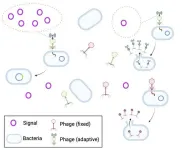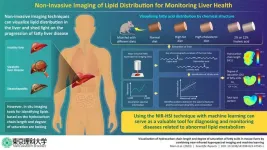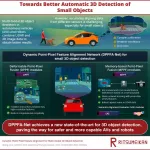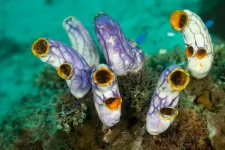(Press-News.org) DALLAS, Jan. 9, 2024 — A physician-scientist from Massachusetts researching whether chemicals naturally occurring in foods could help treat heart disease, a genetics expert from Pennsylvania exploring the molecular mechanisms of lipid metabolism and cardiovascular diseases and a California-based professor of cardiovascular medicine studying how vaping impacts the development of abdominal aortic aneurysms are the most recent American Heart Association Merit Award recipients. Over the next five years, each researcher will receive a total of $1 million in funding from the Association, the world’s leading voluntary organization focused on heart and brain health and research, now celebrating 100 years of lifesaving work.
The American Heart Association’s Merit Award is one of the highest honors given by the Association. The Merit Award supports highly promising, novel research that has the potential to move cardiovascular science forward quickly, with high impact. The recipient of the 2024 award are:
Joseph Loscalzo, M.D., Ph.D., FAHA, the Distinguished Hersey Professor of the Theory and Practice of Medicine and the Samuel A. Levine Professor of Medicine at Harvard Medical School, former chair of the department of medicine and physician-in-chief emeritus at Brigham and Women’s Hospital in Boston;
Daniel J. Rader, M.D., FAHA, Seymour Gray Professor of Molecular Medicine, chair of the Department of Genetics at the Perelman School of Medicine at the University of Pennsylvania School of Medicine and chief of the Divisions of Human Genetics at Penn Medicine and the Children’s Hospital of Philadelphia; and
Philip S. Tsao, Ph.D., FAHA, a professor of medicine in cardiovascular medicine at Stanford University School of Medicine and associate chief of staff for precision health at the VA Palo Alto Health Care System in Palo Alto, California.
“This award supports exceptional scientists with established track records of success. These are true innovators who propose novel approaches to major research challenges in the areas of heart disease, stroke and brain health. Specifically, their research has the potential to produce unusually high impact toward the American Heart Association’s mission to be a relentless force for a world of longer, healthier lives,” said, Joseph C. Wu, M.D. Ph.D., FAHA, American Heart Association volunteer president, director of the Stanford Cardiovascular Institute and Simon H. Stertzer Professor of Medicine and Radiology at Stanford School of Medicine. “As a recipient of this award in 2017, I know it comes with great honor and, also, great responsibility. This year’s recipients are already recognized leaders in the field of cardiovascular research, and I know they will meet the next challenges before them as champions of transformative science in our fight against heart disease and stroke.”
Loscalzo’s research will focus on the link between heart disease and certain foods, or chemicals naturally contained in foods. Using high-speed computers and model systems, he plans to explore many of the 135,000 'natural' chemicals that have been identified in the world’s food supply. His research will focus on how these food chemicals interact with proteins in cells to affect how the cell works and, ultimately, which chemicals may protect the heart. Using this information, his team will then investigate ways to use these compounds to create diets that specifically protect against heart disease and lay the groundwork for developing new drugs that can be used for heart disease treatment.
“One might ask what makes this project exciting and worth funding? Many scientists and doctors have worked hard to create diets that are good for your heart in the past. Their work has been based on only a small amount of information about the composition of food, less than 1%. Our approach is much larger in scope,” Loscalzo said. “We will use modern technologies to explore the great number of chemicals in the food supply. We will then be able to identify among them new ‘natural’ therapies for heart disease for the health of all people.”
Rader’s research will focus on new genes and pathways altering lipid metabolism and causing cardiovascular disease revealed through large-scale human genetics. Blood lipids such as cholesterol and triglycerides are causal risk factors for coronary heart disease as well as several other types of cardiovascular disease, such as aortic stenosis). Genetics play a major role in lipid metabolism and cardiovascular disease and many new genes have been identified for which the underlying biology is not understood. Using computational, experimental and human-based studies, Rader will focus on new genes expressed in the liver that modulate both blood lipids and cardiovascular diseases to better understand the molecular mechanisms and determine the potential for new therapeutic approaches.
“While we know many of the risk factors of heart disease are inherited and have identified hundreds of genes involved, we don’t know how most of these genes are affecting the risk of heart disease. We have a huge need to figure out how these genes are working together to promote, or protect, heart disease,” Rader said. “By doing studies in model systems and in humans, we will help solve some of these mysteries and hope to better understand how genes influence the development of cardiovascular disease. Unlocking the biological and cellular mechanisms of heart disease can help us identify novel therapeutic targets that can potentially transform into medical advances to improve population health.”
Tsao’s research will focus on how vaping may impact the risk of developing an abdominal aortic aneurysm (AAA), which is a weakening of the major artery in the abdominal area. Like a bubble on the side of a bicycle tire, pressure within the artery will cause an AAA bubble to continue to grow until it ruptures, often resulting in death. While some genes have been associated with the risk of developing AAA disease, none is thought to cause an AAA by itself. Instead, it is likely a person's lifestyle acts together with genes to drive AAA disease. Smoking is a prevalent risk factor among people who have an abdominal aortic aneurysm.
“Nearly 90% of people with an abdominal aortic aneurysm have a history of tobacco use. In fact, AAA disease is more closely associated with cigarette smoking than any other tobacco-related disease except lung cancer. However, to date, there have been very few studies to explain the relationship between smoking and AAA disease,” Tsao said. “We know even less about the effects of vaping on the development of an AAA. Yet, given how popular vaping is, especially with young adults, understanding the effects on AAA disease is very important. We propose to study the ways by which e-cigarette vapor affects specific genes to worsen AAA growth. By identifying these mechanisms, we hope to discover new ways to treat abdominal aortic aneurysms. Since smoking is related to many diseases, these studies may also help us understand the more broad, long-term health effects of e-cigarettes and vaping.”
Funding scientific research and discovery through initiatives like the annual merit awards is a cornerstone of the century-old American Heart Association’s lifesaving mission. The Association has now funded more than $5.7 billion in cardiovascular, cerebrovascular and brain health research since 1949, making it the single largest non-government supporter of heart and brain health research in the U.S. New knowledge resulting from this funding continues to save lives and directly impact millions of people in every corner of the U.S. and around the world.
Additional Resources:
Multimedia is available in the right column of the release link.
Follow AHA/ASA news on Twitter @HeartNews
###
About the American Heart Association
The American Heart Association is a relentless force for a world of longer, healthier lives. We are dedicated to ensuring equitable health in all communities. Through collaboration with numerous organizations, and powered by millions of volunteers, we fund innovative research, advocate for the public’s health and share lifesaving resources. The Dallas-based organization has been a leading source of health information for a century. During 2024 - our Centennial year - we celebrate our rich 100-year history and accomplishments. As we forge ahead into our second century of bold discovery and impact our vision is to advance health and hope for everyone, everywhere. Connect with us on heart.org, Facebook, X or by calling 1-800-AHA-USA1.
END
Three researchers awarded $1 million each to study new heart disease treatments, causes
The American Heart Association’s 2024 Merit Award winners from Massachusetts, Pennsylvania and California will look at whether chemicals occurring in foods could be used to treat heart disease, try to unravel some of the genomic mysteries of cholesterol
2024-01-09
ELSE PRESS RELEASES FROM THIS DATE:
The value of information gathering for phages
2024-01-09
Phages, the viruses that infect bacteria, will pay a high growth-rate cost to access environmental information that can help them choose which lifecycle to pursue, according to a study. Yigal Meir and colleagues developed a model of a bacteria-phage system to investigate how much the viruses should be willing to invest to acquire information about their local environment. A temperate phage, once inside a bacterium, can choose one of two life cycles. In the lytic cycle, the phage turns the bacterium ...
Protecting newborns: Research lays the groundwork for a lifesaving vaccine
2024-01-09
BINGHAMTON, N.Y. -- Researchers from Binghamton University, State University of New York are unraveling the workings of Group B Strep (GBS) infections in pregnant women, which could someday lead to a vaccine.
One in five pregnant women carry Streptococcus agalactiae (Group B Strep or GBS) in the vaginal tract, which is typically harmless — except when it isn’t.
The bacterial infection poses serious and even fatal consequences for newborns, including pneumonia, sepsis and meningitis, which can have long-term effects on the child’s cognitive function.
Researchers ...
New study unveils machine learning-aided non-invasive imaging for rapid liver fat visualization
2024-01-09
Steatotic liver disease (SLD), previously known as non-alcoholic fatty liver disease, which includes a range of conditions caused by fat build-up in the liver due to abnormal lipid metabolism, affects about 25% of the population worldwide, making it the most common liver disorder. Often referred to as “silent liver disease,” SLD progresses without noticeable symptoms and can lead to more severe conditions like cirrhosis (liver scarring) and liver cancer.
A liver biopsy—an invasive procedure involving liver tissue sample extraction from the body—is ...
Towards more accurate 3D object detection for robots and self-driving cars
2024-01-09
Robotics and autonomous vehicles are among the most rapidly growing domains in the technological landscape, with the potential to make work and transportation safer and more efficient. Since both robots and self-driving cars need to accurately perceive their surroundings, 3D object detection methods are an active area of study. Most 3D object detection methods employ LiDAR sensors to create 3D point clouds of their environment. Simply put, LiDAR sensors use laser beams to rapidly scan and measure the ...
How fruit bats got a sweet tooth without sour health
2024-01-09
Levi Gadye, 628-399-1046
Levi.Gadye@ucsf.edu | @UCSF
Video: https://ucsf.app.box.com/s/i3atd54ye4m1z1spi0qf59axq7tq7640
Subscribe to UCSF News
A high-sugar diet is bad news for humans, leading to diabetes, obesity and even cancer. Yet fruit bats survive and even thrive by eating up to twice their body weight in sugary fruit every day.
Now, UC San Francisco scientists have discovered how fruit bats may have evolved to consume so much sugar, with potential implications for the 37 million Americans with diabetes. The findings, published on Tuesday, Jan. 9, 2024 in Nature Communications, point to adaptations ...
Vaccine demonstrates potential in delaying relapse of KRAS-mutated pancreatic and colorectal cancers
2024-01-09
HOUSTON ― A vaccine showed potential to prevent relapse of KRAS-mutated pancreatic and colorectal cancers for patients who had previously undergone surgery, according to a Phase I trial led by researchers at The University of Texas MD Anderson Cancer Center. Results were published today in Nature Medicine.
In the trial, patients with pancreatic and colorectal cancer who were considered at high risk of relapse received a maximum of 10 doses of the ELI-002 vaccine targeted toward KRAS G12D and G12R mutations. T cell responses were seen in 84% of all patients and in 100% of those in the two highest dose cohorts, including those who ...
Smart skin bacteria are able to secrete and produce molecules to treat acne
2024-01-09
International research led by the Translational Synthetic Biology Laboratory of the Department of Medicine and Life Sciences (MELIS) at Pompeu Fabra University has succeeded in efficiently engineering Cutibacterium acnes -a type of skin bacterium- to produce and secrete a therapeutic molecule suitable for treating acne symptoms. The engineered bacterium has been validated in skin cell lines and its delivery has been validated in mice. This finding opens the door to broadening the way for engineering non-tractable bacteria to address skin alterations and other diseases using living therapeutics.
The research team is completed by scientists from the Bellvitge Biomedical Research ...
Stranger than friction: A force initiating life
2024-01-09
As the potter works the spinning wheel, the friction between their hands and the soft clay helps them shape it into all kinds of forms and creations. In a fascinating parallel, sea squirt oocytes (immature egg cells) harness friction within various compartments in their interior to undergo developmental changes after conception. A study from the Heisenberg group at the Institute of Science and Technology Austria (ISTA), published in Nature Physics, now describes how this works.
The sea is full of fascinating life forms. From algae and colorful fish to marine snails and sea squirts, a completely different world reveals itself underwater. Sea squirts or ascidians in particular are very unusual: ...
Different biological variants discovered in Alzheimer's disease
2024-01-09
Dutch scientists have discovered five biological variants of Alzheimer's disease, which may require different treatment. As a result, previously tested drugs may incorrectly appear to be ineffective or only minimally effective. This is the conclusion of researcher Betty Tijms and colleagues from Alzheimer Center Amsterdam, Amsterdam UMC and Maastricht University. The research results will be published on 9 January in Nature Aging.
In those with Alzheimer's disease, the amyloid and tau protein clump in the brain. In addition to these clumps, other biological processes such as inflammation and nerve ...
Alzheimer Europe adopts position on anti-amyloid therapies for Alzheimer’s disease, issuing a call to action for timely, safe and equitable access
2024-01-09
Luxembourg, 9 January 2024 – In a new position paper, and following engagement with its national members and the European Working Group of People with Dementia (EWGPWD), Alzheimer Europe calls for concrete actions to enable timely, safe and equitable access to anti-amyloid drugs, for patients who are most likely to benefit from these innovative new treatments for Alzheimer’s disease (AD).
The growing prevalence and impact of AD has catalysed huge investments in research on its causes, diagnosis, treatment and care. After many high-profile ...
LAST 30 PRESS RELEASES:
Review article | Towards a Global Ground-Based Earth Observatory (GGBEO): Leveraging existing systems and networks
Penn and UMich create world’s smallest programmable, autonomous robots
Cleveland researchers launch first major study to address ‘hidden performance killer’ in athletes
To connect across politics, try saying what you oppose
Modulating key interaction prevents virus from entering cells
Project explores barriers to NHS career progression facing international medical graduates
Jeonbuk National University researchers explore the impact of different seasonings on the flavor perception of Doenjang soup
Two Keck Medicine of USC Hospitals named Leapfrog Top Teaching Hospitals
World-first discovery uncovers how glioblastoma tumours dodge chemotherapy, potentially opening the door to new treatments
A fatal mix-up: How certain gut bacteria drive multiple sclerosis
New AI tool identifies not just genetic mutations, but the diseases they may cause
Deep-learning model predicts how fruit flies form, cell by cell
Combination pills for high blood pressure may simplify treatment, improve long-term health
Immune system keeps mucosal fungi in check
Neurons within the brain use simple rules to localize genetic messages
Electrodes created using light
Second-hand gift-giving is a well-deliberated decision
How human interaction drove evolution to make bears less aggressive
National Poll: Few parents offer teens guidance on healthy eating during holiday season
Cannabis derivatives could provide new ovarian cancer treatments
Raising strong yeast as a petroleum substitute
Clues to the origin of hot Jupiters hidden in their orbits
Canada’s reduced pledge to Global Fund will impact domestic health
1 in 4 children with major traumatic injuries not cared for in pediatric trauma centres
Duke and Duke-NUS’ joint cross-population research to uncover "East-West" differences in disease and care
Scientists to ‘spy’ on cancer- immune cell interactions using quantum technology breakthrough
Tech savvy users have most digital concerns
Making lighter work of calculating fluid and heat flow
Normalizing blood sugar can halve heart attack risk
Lowering blood sugar cuts heart attack risk in people with prediabetes
[Press-News.org] Three researchers awarded $1 million each to study new heart disease treatments, causesThe American Heart Association’s 2024 Merit Award winners from Massachusetts, Pennsylvania and California will look at whether chemicals occurring in foods could be used to treat heart disease, try to unravel some of the genomic mysteries of cholesterol




